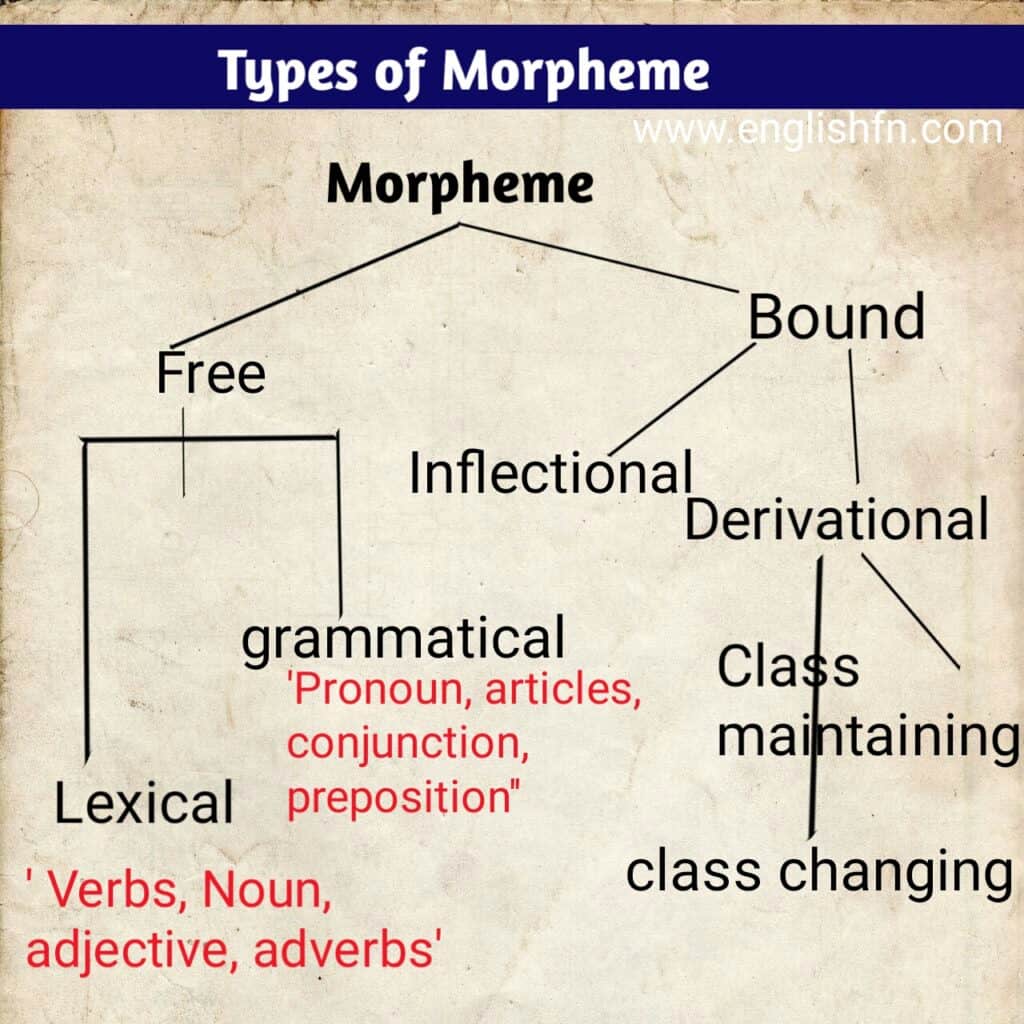Morphology, which is one of the important topics in linguistics. In this article we are going to discuss in details of morphology. Definition of morpheme ,types of morpheme | free morpheme and bound morpheme. inflectional and derivational morphology. class maintaining derivational morphemes |class changing derivational suffixes with examples.
morphology definition/meaning:
And Morphology is an important aspects of linguistics analysis. Morphology which studies the word, its creation, its origin and its uses in different form. In simple word, morphology is a scientific study of words and word forms. Morphology deals with how words are added in language by different processes or by various ways. As phonology studies smallest distinctive elements of sounds in language. In the same way morphology studies the smallest distinctive and meaningful word elements in a language. Which is not only the synchronic study of word forms. but also of the development of word forms. Thus, it is both the synchronic and diachronic study of word forms.
And a morpheme may described as a sequence of sounds un a meaningful combination. Any word or parts of a word in the language which has a meaning of its own and which cannot be further split into a smaller meaningful units is a morpheme. “a morpheme is a minimal/ smallest meaningful unit of a word.” Morpheme also sometime refer as a minimal, meaningful linguistic sign. Morphemes are also referred as monem in a French language.
Types: free morpheme and bound morpheme:

morphology |Morpheme can be satisfactorily classified as free morpheme and bound morpheme.
1. Free morpheme:
Free morphemes are the morpheme which have independent meaning without being combined with others. They can occur alone and they ,have separate meaning and can be used freely in sentences. That is why its called free morpheme. For example: boy, bird, cat etc. are free morpheme. These morphemes are word categories such as ‘lexical morphemes’ and grammatical morpheme ‘. Lexical morpheme is the word category which includes verbs, nouns, adjectives, adverbs, etc.For example: lexical morphemes such as boy, girls, chair, clever, john, nice, etc. And grammatical morpheme is the word category which includes grammatical items like pronouns, conjunctions, articles, prepositions, etc.
2. Lexical morpheme: lexical morpheme carry the content or meaning of the messages that we convey. Those morphemes are having meaning by themselves. For example: follow, strange, ;look, fine, current, etc.
you can also read linguistic study of language.
3. Grammatical morpheme:
Grammatical morphemes specify a relationship between other morphemes. But the difference is not all that well defined. These are the morpheme that do not carry the content of the message, but rather help the grammar of the sentence function. For example: of the grammatical morpheme : and when, ahead , on, that, if, them, near etc.
4. Bound morpheme:
Bound morpheme is the another category of morphemes. These are the morpheme which can not occur alone and do not have meaning in isolation. And if they added to the bases they get meaning. Bound morphemes or depended morphemes which depend on free morphemes for having their own meaning. All suffixes and prefixes are bound morphemes. Bound morphemes are considerers to be two types:
a.Inflectional morpheme
b.Derivational morpheme
a) inflectional morpheme definition:
Inflectional morphemes are bound morpheme which change class aspect of the words. Inflectional morpheme like –ing – ed, -es, are inflectional morphemes. Because they inflect the word classes tense aspects. As for example: played, taken, sleeping, makes, etc.
b) Derivational morpheme :
Derivational morpheme are the morphemes. which brings a change in the word and add a new word in a language. Derivational morphemes derived different words into the English language.
There are two types of derivational morphemes which are –
- Class changing derivational
- And class maintaing derivational
- class changing derivational morphemes: Class changing derivational are the morphemes (suffixes) after added to the base change the word category.The Class changing derivational morphemes like –or, -er, -ly, etc. change category of the word after addition.
-or -act = actor
-er -play= player
-ly -slow= slowly.
2. class maintaining derivational morphemes:
Class maintaining derivational, these are the morpheme of suffixes by which after addition of these morphemes to the base form of the word, the word does not change its category/class such morphemes are called class maintaining derivational. In simple word words there are some bound morphemes if we added the to the base form of the word , the base word does not change class, they remain the same such morphemes are called the class maintaining derivational morphemes.
Conclusion
Morphology is the study of the smallest units of grammatical combination. That are interpreted in form (sound) and meaning. It covers the study of etymology of the words. ie. known formation as word formatiom in linguistical language. It covers too, the smallest to largest aspects of the words in language. The study of morphology takes all these aspects to linguistical study in total.
